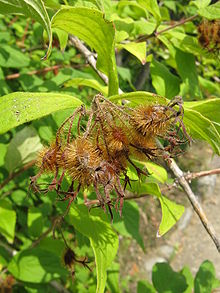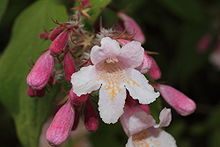Kolkwitzie
| Kolkwitzie | ||||||||||||
|---|---|---|---|---|---|---|---|---|---|---|---|---|

Kolkwitzia amabilis |
||||||||||||
| Systematics | ||||||||||||
|
||||||||||||
| Scientific name of the genus | ||||||||||||
| Kolkwitzia | ||||||||||||
| Graebn. | ||||||||||||
| Scientific name of the species | ||||||||||||
| Kolkwitzia amabilis | ||||||||||||
| Graebn. |
The linnaea amabilis ( Kolkwitzia amabilis ) or the mother of pearl shrub is the only plant species of the genus Kolkwitzia within the family of the Caprifoliaceae (Caprifoliaceae). The species Kolkwitzia amabilis originally comes from China. It was only known relatively late in Central Europe as a flowering shrub and the varieties are now used as ornamental shrubs in parks and gardens in temperate climates.
description
The Kolkwitzia is a deciduous, upright shrub that reaches heights of 3 to 4 meters. The branches have a brown, peeling bark , the branches, which lean over in wide arches, are initially finely hairy and later smooth. All buds are the same size, about 2 to 5 millimeters long, pointed ovoid and protruding from the branch. They are covered by four to five pairs of pointed, brown, more or less densely haired bud scales. Terminal buds are missing.
The leaves are arranged opposite one another. The petiole is 2 to 3 millimeters long and hairy with bristles. The simple leaf blade is broadly ovate and 3 to 9 inches long, pointed with a rounded base. The leaf margin is sawn away to almost entire and ciliate. The upper side of the leaf is dark green and hairy, the nerves on the underside are coarse hairy. Stipules are missing.
The flowers stand singly or in pairs in 5 to 7 centimeters wide trugdoldigen inflorescences at the end of short side branches. When the flowers are arranged in pairs, the base of the ovary is directly above six bracts and when the flowers are arranged individually, they are above four bracts. The bracts, which are fused with the ovary, are very hairy and lignified until the fruit is ripe and cover the fruit as stiff bristles.

The hermaphrodite and zygomorphic flowers have a double perianth . The five sepals are narrow, spreading, hairy and also preserved on the fruits. The five pale pink petals are 1.5 centimeters long, bell-shaped fused with two crown lips. The lower lip ends in three and the upper lip in two extended corolla lobes. The hairy crown throat is yellow-orange. The four stamens are as long as the corolla tube and partly fused with it. Three or four carpels are at a constant under bottle-shaped, three- or vierfächrigen ovary fused, wherein only one or two compartments are fertile and sterile, respectively two rows, but only one fertile ovule contains. If the flowers are in pairs, then their ovaries have grown together. The downy, hairy styles are about as long as the corolla tube and do not protrude beyond the crown; they end in a heady scar. The flowering period extends from May to June.
Closing fruits 0.7 to 1 centimeter long are formed. They are densely hairy with bristles. The dried calyx remains as a 3 millimeter long beak. The fruits ripen from August to September. The seeds contain a small, straight embryo and a large amount of endosperm .
The chromosome number is 2n = 32.
Distribution and location requirements
The wild, rarely occurring Kolkwitzia amabilis comes from the Chinese provinces of Anhui , Gansu , Henan , Hubei , Shaanxi , Shanxi and perhaps Hebei .
There you can find them at altitudes between 300 and 1300 meters. It thrives on mountain slopes, on roadsides, in species-rich forests and groups of trees. The robust shrubs prefer moderately dry to fresh soils that are weakly acidic to alkaline and rich in nutrients, but avoid sands and clays. They thrive in sunny to light-shaded locations and are frost hardy.
Comprehensive studies on the biogeography and phylogenetics of the Linnaeoideae are now available in a freely accessible publication.
Systematics
The Kolkwitzia ( Kolkwitzia amabilis ) is the only species of the genus Kolkwitzia . This is either part of the Linnaeaceae family or the Linnaeoideae subfamily within the honeysuckle family (Caprifoliaceae). Synonyms are Kolkwitzia amabilis var. Calicina Pampanini and K. amabilis var. Tomentosa Pampanini.
Botanical history
The Kolkwitzia was discovered late and was not in culture in ancient China either. The Italian Father Giuseppe Giraldi, who was a missionary in the Shaanxi province from 1890 to 1895 , found fruiting specimens and put evidence of them in his herbarium . He sent his collection to Florence, from where it was passed on to the Botanical Museum in Berlin for identification. There, Karl Otto Graebner recognized from the fruit characteristics that it was a new species and a new genus of the honeysuckle family . He named the genus after his friend Richard Kolkwitz (1873-1956) and gave it the specific epithet amabilis ( Latin for "lovable"). Richard Kolkwitz later became famous as a co-founder of wastewater biology and biological-ecological water analysis. Its name goes back to the Sorbian town of Kolkwitz near Cottbus . The first publication on Kolkwitzia appeared in 1901 in the Flora von Central-China by Ludwig Diels in Volume 29 of the Botanical Yearbook.
Around 1900 the plant collector Ernest Henry Wilson sent seeds of Kolkwitzia from the province of Hubei to England, where they were sown in the nursery of Veitch and Sons . Young plants from it were identified at the Botanical Garden in Kew as representatives of Kolkwitzia amabilis and presented in the Kew Bulletin in 1909 , although the species had not flowered in England at that time. The Kolkwitzie was described as "not very attractive and only suitable for enthusiasts". In 1910 the shrub first bloomed in the gardens of Veitch and became popular in England after several publications with pictures of the flowering shrub. Wilson also brought the shrub to the United States, where it became known as the "Beauty Bush". In Germany, the shrub did not become more widespread until 1930, and it only became common after the Second World War.
The Chinese name of this plant is wèi shí (猬 实 , traditional character: 猬 實). It comes from some provinces in central and northwest China. There is no regional difference for this designation. Wèi 猬 means “hedgehog” and shí 实 means “fruit”. The bristly hairy capsule resembles a small hedgehog. Cultural or literary meanings are not known.
use
The Kolkwitzia varieties are used in the temperate areas as an ornamental shrub in parks and gardens because of their decorative flowers .
proof
literature
- Andreas Roloff , Andreas Bärtels: Flora of the woods. Purpose, properties and use. With a winter key from Bernd Schulz. 3rd, corrected edition. Eugen Ulmer, Stuttgart (Hohenheim) 2008, ISBN 978-3-8001-5614-6 .
- Schütt, Schuck, Stimm: Lexicon of tree and shrub species . Nikol, Hamburg 2002, ISBN 3-933203-53-8 , pp. 250 .
- Heinz-Dieter Krausch : Imperial crown and peonies red ... From the discovery and introduction of our garden flowers. Deutscher Taschenbuch Verlag, Munich 2007, ISBN 978-3-423-34412-8 , pp. 247-248 .
- Qin-er Yang (杨 亲 二) & Sven Landrein: Linnaeaceae : Online - Flora of China . Kolkwitzia is the 4th genus there. (Section description, distribution and systematics)
Individual evidence
- ^ Dorothée Waechter: Lazy - The plants . All kinds that make it easy for you in the garden. blv, Munich, ISBN 3-405-16486-9 , pp. 81 .
- ↑ a b c d Roloff et al .: Flora der Gehölze , p. 362
- ↑ a b c d e f Qin-er Yang (杨 亲 二) & Sven Landrein: Linnaeaceae : Online - Flora of China (draft) . ( Memento of the original from July 14, 2010 in the Internet Archive ) Info: The archive link was inserted automatically and has not yet been checked. Please check the original and archive link according to the instructions and then remove this notice.
- ↑ Wang HF, Landrein S, Dong WP, Nie ZL, Kondo K, Funamoto T, Wen J, Zhou SL: Molecular phylogeny and biogeographic diversification of linnaeoideae (caprifoliaceae s. L.) disjunctly distributed in Eurasia, North America and Mexico. , PLoS One. 2015 Mar 10; 10 (3): e0116485, PMID 25756215
- ↑ Roloff et al .: Flora of the Woods , p. 361
- ↑ Lotte Burkhardt: Directory of eponymous plant names . Extended Edition. Botanic Garden and Botanical Museum Berlin, Free University Berlin Berlin 2018. [1]
- ^ Krausch: Kaiserkron and Peonies red ... , p. 247
- ↑ Krausch: Kaiserkron and Peonies red ... , p. 248


